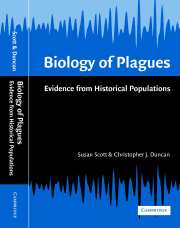Book contents
- Frontmatter
- Contents
- Preface
- Conversion table for imperial to metric units
- 1 Introduction
- 2 Epidemiological concepts
- 3 The biology of bubonic plague
- 4 The Great Pestilence
- 5 Case study: the plague at Penrith in 1597–98
- 6 Pestilence and plague in the 16th century in England
- 7 Plagues in the 16th century in northern England: a metapopulation study
- 8 Plagues in London in the 17th century
- 9 Plagues in the provinces in the 17th century
- 10 Plague at Eyam in 1665–66: a case study
- 11 Continental Europe during the third age of plagues: a study of large-scale metapopulation dynamics
- 12 The plague at Marseilles, 1720–22: an outbreak of bubonic plague?
- 13 Conclusions
- References
- Index
13 - Conclusions
Published online by Cambridge University Press: 28 October 2009
- Frontmatter
- Contents
- Preface
- Conversion table for imperial to metric units
- 1 Introduction
- 2 Epidemiological concepts
- 3 The biology of bubonic plague
- 4 The Great Pestilence
- 5 Case study: the plague at Penrith in 1597–98
- 6 Pestilence and plague in the 16th century in England
- 7 Plagues in the 16th century in northern England: a metapopulation study
- 8 Plagues in London in the 17th century
- 9 Plagues in the provinces in the 17th century
- 10 Plague at Eyam in 1665–66: a case study
- 11 Continental Europe during the third age of plagues: a study of large-scale metapopulation dynamics
- 12 The plague at Marseilles, 1720–22: an outbreak of bubonic plague?
- 13 Conclusions
- References
- Index
Summary
The receptor for the entry of HIV
Information about the nature of the infectious agent in the Black Death has recently come from an unexpected source, namely the studies in molecular biology of acquired immunodeficiency syndrome (AIDS). The discovery that the CCR5 gene product encodes a transmembrane G-protein-coupled receptor on macrophages and monocytes that serves as an entry port (or chemical doorway) for primary human immunodeficiency virus (HIV)-1 strains represented a major step forward in our understanding of this disease (Alkhatib et al., 1996; Choe et al., 1996; Deng et al., 1996; Doranz et al., 1996; Dragic et al., 1996). A 32 base-pair deletion mutation that interrupts the coding region of the CCR5 chemokine receptor locus on human chromosome 3p21 was subsequently described (Dean et al., 1996; Liu et al., 1996; Samson et al., 1996); this CCR5-Δ32 mutation, which causes a frameshift at amino acid residue 185 (Carrington et al., 1997), leads to truncation and loss of the receptor on lymphoid cells so that homozygous individuals have nearly complete resistance to HIV-1 infection and heterozygotes for the mutation delay the onset of AIDS (Dean et al., 1996; Huang et al., 1996; Biti et al., 1997; Michael et al., 1997; O'Brien et al., 1997; Theodorou et al., 1997; Zimmerman et al., 1997). Sixteen additional mutations in the coding region of the CCR5 gene have now been identified (Carrington et al., 1997).
- Type
- Chapter
- Information
- Biology of PlaguesEvidence from Historical Populations, pp. 352 - 395Publisher: Cambridge University PressPrint publication year: 2001



